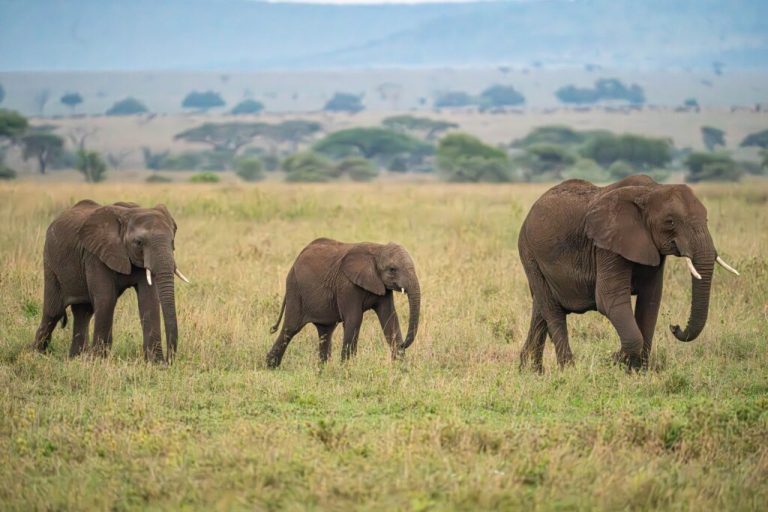On recent Tanzanian safari, we fell in love (love love) with the undisputed giants in the animal kingdom. African elephants are one of the most amazing creatures to roam the Earth. Thanks to their amazing intelligence, social ties, and strange behaviors, they are more than just great beauty-it is one of the most important natural tasks in nature. Here are 10 enjoyable facts about African elephants that will leave you in awe (and perhaps a little muffled laugh).
Family first, always
African elephants are the children’s label for family values. They live in the narrow -her -led shells that are a female (and is usually older) female. These herds are similar to the reunification of the extended family that never ends, with sisters, aunts and cousins who are tired of young people. Meanwhile, males are expelled as teenagers, forming a bachelor’s degree or going alone – on their mark as years of gap in the elephant.
We have seen the first Felna families to play in the mud in the Targayr National Park. Until we got to see the children of Itty Bitty, they breastfeed their mothers. However, our best meeting was with a huge crossfire in front of the serum airfly at dusk in the center of Serengietti. We have seen how the entire family surrounded the small elephants to keep it safe from anything approaching.
Trunks: Natural Swiss Army knife
The elephant box is not only for display; It is a multi -use tool that is part of diving, part of the hand, and the partial pillar. With more than 40,000 muscles, they can use it to pick up a single blade of grass or get rid of an entire tree. And yes, it is known that they sprinkle with human reassured people. Fun or trivial? You decide.
The things we saw in the elephants with their trunks were simply amazing. However, the best thing ever is to watch adolescent elephants that stumble in their trunks over their developing fangs. The puberty of the elephant is real and embarrassing as it was for all of us.
Speake days of clay spa
Mud baths are not just luxury – they are necessary for African elephants. The rolling in the clay cools them and protects their skin from the sun, and maintains annoying insects in the Gulf. Watching the elephant five tons floundering in a muddy pond, with abandonment of elaboration is pure joy. It is like a small child who discovers ponds, but on a huge scale.
We saw this behavior in Tarangir and they were excited. Who was thinking that the monster covered with five tons could be very nice?
Tanzania: the central elephant
Tanzania is one of the best places to see African elephants in its natural environment. From the sprawling plains of SERENGETI to the landscape set in Papab in the National Tarangire Park, these tendant giants wander, and often provide exciting safari moments. Discovering them under the Aquassia tree or going through a watering hole? Very creative.
We have seen the elephants in each of the three parks that we visited on our African safari flights: TARANGIRE, SERENGETI and Ngorogoro Crate. In each of these parks, we can see how the elephants adapt to their surroundings and seem perfectly at home in the Tanzanian countryside.
Tree stations
African elephants not only eat plants, but also reshape the landscape. The talent of payment on trees may seem destroyed, but vital to the ecosystem. By clearing the vegetation, they create open spaces for other animals and even help new plants grow. They are essentially the bulldozers of nature, but WAY Cux.
When moving to our Cyrengate camps, we can see how the elephants were constantly bound and balanced trees with the savanna. There are even scientific studies that take place between mammothy wool genes with African elephants so that they can remove trees from the soil in the Arctic – literally, wonderful!
Large ears, great purpose
Those huge ears are not only for display; They are temperature organizations. African elephants use their ears like giant fans to cool them, and raise them to rotate blood and release heat. We found that it was noticeably cold and comfortable in Tanzania’s visit in November, but the elephants were always busy raising their ears. If we come in the middle of the drought season, it seemed that they were preparing to take off!
Silent communication
Elephants have a secret social network: infrared communication. It produces low -frequency sponsors that are transmitted across the Earth for miles. It is similar to the text messaging system from a box to Trunk-Trunk, allowing them to warn of danger, locate each other, or spread the word about the best irrigation hole in the city.
The elephants that we have seen were always social. They were in a narrow cohesive group and they were upset with each other and their youth. However, they did not face any problems clarifying their ideas if the mood hit them.
Memory is like steel trap
I heard the saying, “The elephant is never forgotten,” and this is often true. African elephants have incredible memories, which help them navigate in wide landscapes and remember water resources sites during dry seasons. They are also known to get to know the people who have previously faced – so carefully if you are ever at the ended end of the water spray.
We traveled to the far western end of Serengeti and we can see a vast garden. The ability of elephants and all animals to move in this vast extension and find food and water simply amazing!
Great appetite
African elephants spend up to 16 hours a day in eating and can consume more than 300 pounds of food per day. Their diet includes grass, fruits, barks and roots, and they are not ashamed to raid farm crops if they give the opportunity. With such an appetite, it’s no wonder that they are always in the event of moving.
The beautiful thing in Tanzania was the amount of space in these wonderful creatures. We had experience in Sri Lanka, where it visited the elephants (and was somewhat destroyed) rice fields in the decline of the Ayurveda in which we were staying. A big boy must eat!
Water -loving wandering
Elephants have the strange ability to find water, even in more dry conditions. Their trips often revolve around these precious resources, making them vital for other animals in the ecosystem. When the elephants find water, everyone benefits from thirsty antelopes to opportunistic birds.
In the Tarangire River, we can see where the elephants were dug into the hidden water in the dry bed. Inside each elephant hole was a prosperous society of animals with access to water.
The conclusion of enjoyable facts about African elephants
African elephants are more than just the largest ground animal; They are environmental engineers, social butterflies, and absolute pleasure to see it in their natural environment. Whether they spray vibrantly in a clay bath or reshape the tendennut wilderness, these amazing creatures display the unlimited beauty of nature. We were lucky enough to witness them at work – which is heading to something in the elephant – on our luxurious safaria with the travel of Altza. The experiment was not less than magic! In the afternoon, which died in the afternoon to monitor these gentle giants is a sufficient reason to explore the wilderness and a strong reminder of the reason for the importance of protecting their habitats.
Hello! We are Jin and Ed Coleman, nicknamed Coleman Conserge. In short, we are a Gen X couple whose Huntsville is sharing our stories about amazing adventures through the transformational and experimental travel that depends on the activity.

